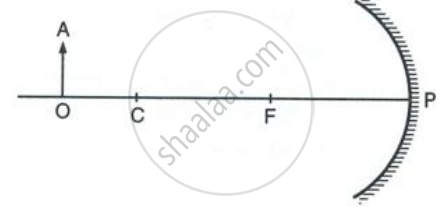Advertisements
Advertisements
प्रश्न
An object forms a virtual image which is 1/8th of the size of the object. If the object is placed at a distance of 40 cm from the convex mirror, calculate:
- the position of the image
- the focal length of the convex mirror.
उत्तर
Let size of the object = h0 = x
Size of the image h1 = `"x"/8` = + 1.25 cm
Distance of the object from the converx mirror = u = - 40 cm
Distance of the image from the convex mirror = v = ?
(i) Magnification = m = `"h"_1/"h"_0 = - "v"/"u"`
`("x"/8)/"x" = - "v"/-40`
v = `"x"/"8x" xx 40 = 5` cm
(ii) Using mirror formula:
`1/"u" + 1/"v" = 1/"f"`
We have,
`1/-40 + 1/5 = 1/"f"`
`1/"f" = - 1/40 + 1/5`
`1/"f" = (- 1 + 8)/40 = 7/40`
⇒ f = `40/7 = 5.71` cm
APPEARS IN
संबंधित प्रश्न
Figure shows a concave mirror with its pole at P, focus F and centre of curvature C. Draw ray diagram to show the formation of image of an object OA.

Write two more characteristics of the image.
A concave mirror forms a virtual image of size twice that of the object placed at a distance 5 cm from it.
Find : (a) the focal length of the mirror (b) position of image
Define the following term in relation to concave mirror.
Principal focus
What do you understand by the term real image?
AB is the object, A1B1 is its image. MM' is the position of the mirror. Complete the ray diagram and find the position of the center of curvature and focus of the mirror. Also, measure the focal length.

Spherical mirrors are one form of ______ mirrors.
The image formed in a plane mirror is always inverted.
The minimum length of the mirror required to see the full image of the person is half ‘ of his height.
